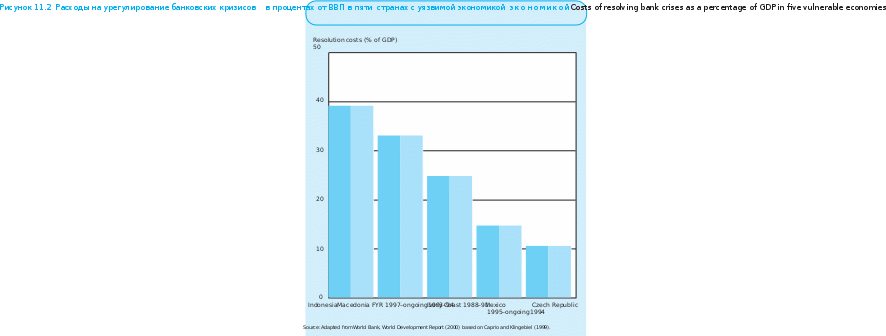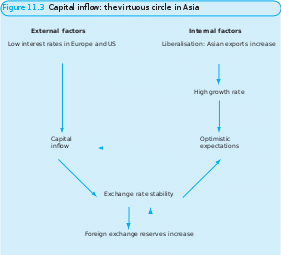 Собственный капитал и долг Собственный капитал и долг
Различие между долевым финансированием и долговым финансированием также является важным. Облигации, банковские кредиты и официальные потоки на цели развития - это долги. Кредит (плюс проценты) должен быть выплачен по номинальной стоимости, независимо от экономических условий страны. Если национальный доход страны падает, она все равно обязана выплатить долг – или объявить дефолт по своему долгу. Портфельные инвестиции и прямые инвестиции - это долевое финансирование. Доходность связана с доходом. Если в экономике происходит спад, доходность падает. Дивиденды, в том числе иностранцам, больше не выплачиваются. Стоимость актива падает. Иностранный инвестор, по сути, разделяет бремя спада в отечественной экономике.
Торговлю иностранными активами можно объяснить с точки зрения выбора портфеля и диверсификации портфеля. Агентами на международном рынке капитала могут быть физические лица или, что более вероятно, коммерческие банки, компании или небанковские финансовые учреждения, такие как пенсионные фонды и страховые компании. Агенты выбирают активы на основе риска и ожидаемой доходности. Глобализация и либерализация предоставляют агентам возможность диверсифицировать свои портфели и снизить риски.
В экономике, в которой существует множество барьеров для инвестиций за рубежом, инвесторам будет трудно приобрести диверсифицированный портфель, поскольку они могут владеть только местными активами. Они будут обязаны "класть все яйца в одну корзину’. Инвесторам нужны диверсифицированные портфели, чтобы снизить риск, и они будут платить премию за диверсификацию. Возможно даже, что новые и неэффективные отечественные фирмы появятся просто для удовлетворения спроса инвесторов на диверсифицированные портфели.
Когда устраняются барьеры для инвестиций за рубежом, инвесторы больше не заинтересованы в инвестировании в неэффективные отечественные компании. Они могут искать эффективные иностранные компании. Неэффективные местные фирмы со временем могут быть вытеснены из бизнеса. В конечном счете, снижение барьеров для инвестиций через национальные границы, вероятно, приведет к созданию рынков, которые будут финансово интегрированы. Рынок, который является финансово интегрированным, позволяет инвесторам диверсифицировать свою деятельность по всему миру и снизить риски. Интегрированные рынки непосредственно ведут к более эффективному распределению ресурсов.
 In the 1990s private financial flows which crossed national borders grew rapidly and started to outstrip the growth in trade. Private flows increased as official flows declined (Figure 11.1). Why did cross-border flows increase so dramatically? In the 1990s private financial flows which crossed national borders grew rapidly and started to outstrip the growth in trade. Private flows increased as official flows declined (Figure 11.1). Why did cross-border flows increase so dramatically?
Developed, developing and transition countries liberalised their capital accounttransactions, as part of the wider move to market orientation.
There was a significant amount of financial innovation which created new invest- ment opportunities (e.g. derivatives, hedge funds). This brought new risks of course.
In Europe and the US, many post-war ‘baby boomers’ neared retirement. They sought high returns for their significant pension assets. Hence pensionandmutualfundsbegan to look abroad for profitable investment outlets.
Developingcountriescontinued to require huge amounts of financial capital to cope with their rapidly growing populations. They also began to constitute the fastest-growing market for the products of multinational companies. This attracted privatecapitalflows. To some extent, these flows have come about at the expense of official development assistance (Figure 11.1).
Innovations in telecommunications and computer technologies reduced transaction costs and enabled financial markets to ‘go global’. This was particularly applicable to emerging markets in developing countries. Banking and financial markets, and the regulatory framework in developing countries, had previously been considered too weak to sustain significant capital inflows.
Economists have long held that foreign capital has a unique role to play in raising living standards. Foreign investment increases the number of resources available to an economy. Usually it stimulates jobs, skills and managerial and technical know- how. Often it provides market access, as multinationals search the world to source their goods and sell their products. Yet there is a downside. International capital flows expose recipient countries to waves of speculation and changes in investor sentiments. Volatile capital flows can lead to volatilities in exchange rates and hold- ings of official reserves. They can threaten banks and wreak havoc with stabilisation policies. Most seriously of all, in some of the most vulnerable economies in the world, the financial turbulence associated with financial crises can have massive implications for national income. Figure 11.2, adapted from the World Bank’s WorldDevelopmentReportof 2000, illustrates this latter point. It shows the huge costs involved in resolving bank crises in five vulnerable economies in the 1990s.
This chapter is concerned with the reasons for capital inflows and their reversals. There are theoretical, empirical and policy issues. But it is important to recognise that third-generation models, which link currency crises to the behaviour of the financial sector, represent a new and developing area of economics. Through the 1960s, 1970s, and 1980s the parameters which determined the flow of funds across national bound- aries were believed to be fairly well understood. Then in the 1990s the situation changed dramatically. Market-orientated reforms were implemented. The Berlin Wall came down and parts of the world which, for close on half a century, had been

isolated from global financial markets, suddenly received massive financial flows to restructure their economies. Innovations in the financial sector put the spotlight on investor behaviour. In view of the scale and speed of the changes, it is not surprising that much of the research into capital flows is on the frontiers of economic know- ledge. Adam Smith and the classical economists tended to believe that everyone reacts to markets in a similar way. Classical models of human behaviour assume
uniform market reactions. But in the context of investor behaviour this assumption is invalid. Market-makers, speculators and portfolio managers all have very different goals and very different time horizons. It makes for interesting but difficult dynamics. In spite of tremendous progress during the last few years, the economics profession still does not understand fully the anatomy of a currency crisis.
 Capital flows into Asia rose sharply between 1990 and 1996, and at the time were seen essentially in a virtuous light. As interest rates began to fall in the US and Europe, institutional investors began to search for high returns in emerging markets. Fund managers were also looking to diversify internationally. Asia, and emerging markets elsewhere, had liberalised their economies to permit inward investment and had introduced a variety of reforms to their financial markets which proved attractive to investors. This virtuous circle scenario is illustrated in Figure 11.3. Capital flows into Asia rose sharply between 1990 and 1996, and at the time were seen essentially in a virtuous light. As interest rates began to fall in the US and Europe, institutional investors began to search for high returns in emerging markets. Fund managers were also looking to diversify internationally. Asia, and emerging markets elsewhere, had liberalised their economies to permit inward investment and had introduced a variety of reforms to their financial markets which proved attractive to investors. This virtuous circle scenario is illustrated in Figure 11.3.

Capital inflow was kick-started by falling interest rates in Europe and the US in the early 1990s. In Asia, liberalisation had increased exports and had led to a high growth rate, generating optimistic expectations about future returns on Asian investment. Portfolio inflows then underpinned the external values of Asian currencies. The value of the Thai baht, for example, increased significantly. In the early 1990s Thailand received most of the capital inflows to the so-called ‘Asian Tigers’. Korea, Taiwan, Indonesia, Hong-Kong and Malaysia also received large volumes of foreign funds seeking profitable investment outlets.
The virtuous circle was interrupted in 1996–7. Rates of interest were still low in Europe and the US but liberalisation was virtually completed in Asia and the growth rate was falling. In Thailand, Malaysia, Singapore and Korea export-led growth was beginning to lose momentum. Japanese growth was also stalling and the depreciation of the yen began to undermine confidence in Asian prospects. The Thai baht was effectively devalued in 1997, and in July of that year the Thai government asked the IMF for assistance.
The benefits of high returns and diversification for investors from the US and Europe had evaporated. Private capital fled the markets of Thailand, Indonesia, Korea, Malaysia and the Philippines. The virtuous circle of capital inflow had become a vicious circle of capital outflow (see Figure 11.4).
The virtuous and vicious circles were common to all the Asian countries affected by the crisis of 1997. However, Takatoshi Ito, Professor of Economics at Hitotsobashi University in Tokyo, has shown in his empirical work that different Asian countries had differed markedly in the type of capital inflow which they had attracted:
China and Malaysia still continued to attract direct investment. They had no significant portfolio flows. In fact, Malaysia was a net exporter of portfolio capital.
Thailand’s portfolioinflows (bonds, equities and commercial paper) were higher than direct investment. This may be a significant point, since portfolio capital can be easily withdrawn. It is much more difficult to withdraw direct investment which may already have been translated into factories and machinery.
|
 Скачать 142.55 Kb.
Скачать 142.55 Kb.